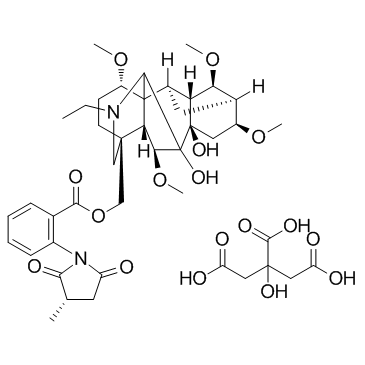| Description |
Methyllycaconitine citrate is a specific antagonist of α7 neuronal nicotinic acetylcholine receptor (α7nAChR).
|
| Related Catalog |
|
| Target |
α7nAChR[1]
|
| In Vitro |
Pretreatment with 5 and 10 µM Methyllycaconitine citrate (MLA) inhibits the decreased cell viability induced by Aβ25-35. Cell viability does not decrease after exposure to Methyllycaconitine citrate (2.5, 5, 10, 20 µM). Aβ25-35 treatment increases LC3-II levels, which is inhibited by administration of Methyllycaconitine citrate. Methyllycaconitine citrate also inhibits Aβ-induced autophagosome accumulation in SH-SY5Y cells. Flow cytometry also demonstrates decreased MDC-labeled vacuoles with Methyllycaconitine citrate treatment[1].
|
| In Vivo |
Methyllycaconitine citrate (MLA) (6 mg/kg) given alone intraperitoneally does not cause climbing behavior when compare with the saline group. Pretreatment with Methyllycaconitine citrate significantly inhibits methamphetamine (METH)-induced climbing behavior, by about 50%. Methyllycaconitine citrate does not modify either basal locomotor activity or METH-induced hyperlocomotion. The METH-induced depletion of dopamine neuron terminals is attenuated in mice pretreated with Methyllycaconitine citrate (250±43 fmol/mg, n=7). A direct effect of Methyllycaconitine citrate on body temperature is ruled out because Methyllycaconitine citrate does not affect basal body temperature (37.0±0.5°C, n=5) or reduce the METH-induced hyperthermia (38.2±0.4°C, n=6, MLA+METH group, n.s. versus METH group)[1].
|
| Cell Assay |
Cells are plated in 96-well plates containing complete medium and cultured for 24 h. Then cells are treated with Methyllycaconitine citrate at the indicated concentrations for specified times. After drug treatment, cell viability is measured by MTT assay. Briefly, 10 µL of the MTT solution (5 mg/mL) is added to each well and incubated for 4 h at 37°C. After removing the supernatant, 100 µL DMSO is added into each well. The absorbance is measured at 570 nm with a microplate reader. All experiments are repeated 3 times[1].
|
| Animal Admin |
Adult male Swiss CD-1 mice are used in all experiments. They are housed at 22±1°C under a 12-h light/dark cycle with free access to food and drinking water. Climbing behavior is measured. Briefly, mice of 20 to 26 g are intraperitoneally administered saline (5 mL/kg) or Methyllycaconitine citrate (MLA) (6 mL/kg) at the beginning of the test. Twenty minutes later, the animals receive a single dose of saline or methamphetamine (METH) (1 mL/kg) subcutaneously and are placed individually, for habituation, into the experimental chamber consisting of a cylindrical cage with the wall made of plastic bars and covered with a lid. After a 20-min period of exploratory activity, stereotypy measurement is performed for a period of 30 min[2].
|
| References |
[1]. Zheng X, et al. Methyllycaconitine alleviates amyloid-β peptides-induced cytotoxicity in SH-SY5Y cells. PLoS One. 2014 Oct 31;9(10):e111536. [2]. Escubedo E, et al. Methyllycaconitine prevents methamphetamine-induced effects in mouse striatum: involvement of alpha7 nicotinic receptors. J Pharmacol Exp Ther. 2005 Nov;315(2):658-67.
|
